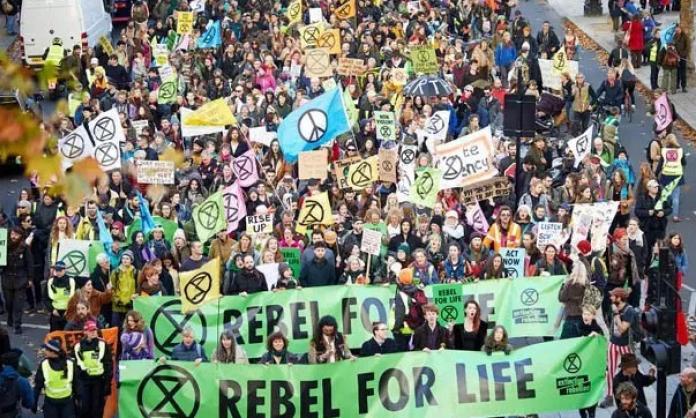There is a climate emergency. And the need for radical and disruptive action to challenge it is becoming common sense. Extinction Rebellion (XR) has gained popularity for occupying central London streets and calling for mass arrests. Greta Thunberg, the Swedish high school student made famous by her climate activism, urges us to act as if our house is on fire. Protests demanding serious action on climate change are on the rise across the world.
Recently, rallies and occupations have taken place in several Australian cities. In some places, such as Brisbane, they have been the largest protests in decades. There have also been two national student strikes in the past six months and the first mass high school walk-outs since the Iraq war. Hundreds of grassroots XR groups have been set up in cities and suburbs across the country.
For years, there has been mass support for urgent action on climate change. But there has been no outlet for it. Environmental politics has been dominated by conservative NGOs that focus on lobbying and lifestyle changes. Though radical sections of the environment movement exist, they have often had a secretive approach to organising.
The moment now is refreshingly different. There is a profusion of new groups, new activists and an enthusiasm to take on the forces responsible for climate change in a direct and uncompromising way. Like any new period of activism, there are weaknesses and potential pitfalls, but there are also debates about politics and the strategies needed to win.
One of the most important focuses is the campaign against the Adani mine. Given the scale of environmental catastrophe facing humanity, it is astounding that a new coal mine has been given the go-ahead. And as anti-Adani activists are aware, it is the advance guard in the wider battle to open the entire Galilee basin for mining.
Opposition to the mine has grown steadily over the last two years. Several polls have shown a majority opposed to it, including in Queensland. And there has been consistent resistance, mainly stunts and direct action in the cities and at the mine site. This has escalated since the federal election and the return of the guy who carries shellacked lumps of coal into parliament (so he doesn’t get his hands dirty).
An XR anti-Adani rally in Melbourne attracted several thousand the week after the election. There have also been sizeable Stop Adani protests in Adelaide, Canberra and Perth. In Sydney, 600 people occupied the intersection of George and Liverpool streets on a Friday night. In Brisbane, protesters have mobilised repeatedly. One involved a brief but significant occupation of Queen Street Mall, a feat activists have not managed since the 1990s due to Queensland’s heavy policing regime. The momentum and size of the rally put the cops on the back foot.
Besides the re-election of the Morrison federal government, the anti-Adani protests have been spurred on by Queensland Labor’s decision to approve the mine. This angered many activists with illusions in Labor, illusions that persisted despite the party’s track record of supporting Adani. Now that one of the company’s biggest defenders, Anthony Albanese, is leading the party and Queensland Labor has continued to prove its fealty to coal, things are clearer: the ALP is part of the problem.
Interestingly, the recent spate of anti-Adani protests has not been called by the longstanding, liberal environment groups, nor by the official Stop Adani collectives. They have been called by more radical groups like XR and Uni Students for Climate Justice. This may partly be because of a right wing backlash against the Stop Adani movement. The accusation that environment activists do not care about jobs and workers has been peddled by the Liberal Party, the Labor Party and even some sections of the left. This argument is aimed at undermining the need for urgent and radical action to stop climate change, not at securing better conditions for workers. It is an argument in the service of the fossil fuel bosses.
Students are at the heart of the new environmental activism. The school student strikes initiated by Greta Thunberg have inspired people all around the world. In Australia, there have been two enormous school strikes, each involving tens of thousands of primary and high school students. The second strike also involved significant contingents of university students, including a 600-strong mobilisation from Sydney University.
At the July National Union of Students conference, university student leaders called a national day of protest on 9 August. Individual campus protests will converge with central demonstrations in all major cities. In Melbourne, organisers have targeted GHD, the company most closely involved with construction of the Adani coal mine. The National Union of Students and Uni Students for Climate Justice will also mobilise for the next major global school strike on 20 September.
Extinction Rebellion is growing around the world. Much like the occupy movement did after the global financial crisis, it reflects the appetite for radical action. People are signing up to be part of the movement by joining their local XR groups and declaring themselves “arrestable”.
Like many new movements, XR has its idiosyncrasies. It has a narrow plan for social change derived from its UK leader Roger Hallam’s manifesto. There are virtues to this – it is inspiring for people to join an organisation with a firm, optimistic vision and clear identity. But some goals laid down in the manifesto may prove too prescriptive.
There are already debates emerging within XR about the way forward. Some are for actions that disrupt little, while others, particularly in the Brisbane XR chapter, want to escalate the level of disruption.
There are also debates about demands. Some emphasise the need to bring government “to the table” or get various arms of government to declare a climate emergency. This is fast becoming a greenwashing strategy of governments, which will not guarantee more action on climate change, let alone the drastic and radical action needed.
To its credit, XR attracts people who want to shake up the system and put their bodies on the line. This is welcome and deserves support. XR’s next major focus is the 7 October global week of action.
Melbourne activists are organising a blockade of the International Mining and Resources Conference (IMARC) happening on 28-31 October. The conference, sponsored by the Victorian government, is a meeting of the most insidious and powerful climate vandals and human rights abusers on the planet.
Besides representatives from all the key firms associated with fossil fuel extraction and production, the conference will host the heads of metal, gold, silver, diamond and uranium mining. The mining corporations that will be attending are not only responsible for environmentally destructive extraction but also land theft, genocide and imperialism. As Thunberg rightly pointed out, individuals are to blame, and they will be wining and dining in Melbourne later this year.
It is a testament to the shift in mood around climate activism that the action will be a blockade. For the last few years, there have been small direct action protests at the IMARC conference. This time, people are feeling inspired to shut down a meeting of the global 1 percent. To do so, tens of thousands of participants will be needed and if successful, the action will become a symbol of the power of mass struggle in taking on the climate criminals and the system they represent.









